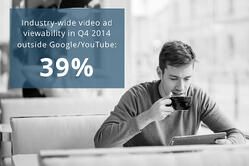Viewability is a concern for many of the CMOs and media planners we speak with. But what exactly is viewability and how can you ensure your ads are actually viewed by your intended audience? Watch this short video for some insights:
This article from Digiday last week explains that the viewability issue has only recently emerged because advancements in digital technology now allow us to measure when an ad appears on a viewer's screen and for how long.
The current industry standard for video ad viewability doesn't really measure a view per se, it measures something called a "viewable impression," which is defined as 50% of an ad's pixels appear in a viewer's window for at least two continuous seconds.
That means if you open a Web page and suddenly hear a video playing, you scroll down to find it and it appears for two seconds before you stop it—that counts as a viewable impression. You'll agree that's a pretty low bar. But the real problem is that only 39% of the video ad CPMs you're buying today meet that standard.
You'll agree that's a pretty low bar. But the real problem is that only 39% of the video ad CPMs you're buying today meet that standard.
That's right—according to Integral Ad Science, in Q4 of 2014, 61% of video ads were not viewable.But that data is a little misleading because it doesn't include Google properties, which run video ads differently than the rest of the industry.
Take YouTube's TrueView video ads, for example.
 Because viewers can skip them after five seconds, they are really the gold standard when it comes to viewability. TrueView ads have been 99.9% viewable since 2011.
Because viewers can skip them after five seconds, they are really the gold standard when it comes to viewability. TrueView ads have been 99.9% viewable since 2011.
Also, YouTube TrueView ads are sold on a cost per view basis, meaning you only pay when a viewer watches your full ad—or 30 seconds, if your ad is longer than that.
So one way to ensure your ads are actually viewed is to buy inventory like TrueView ads on a cost per view basis, not impression-based CPMs.
To learn more about how we can help you run scalable, automated TrueView video ad campaigns, go to our Get Started Page to schedule a brief demo of our platform solution.
Resources:
- "Media buyers are getting ripped off, but guaranteed viewability is here to help," Digiday, February 23, 2015
- Integral Ad Science, “2014 Media Quality Report.”

